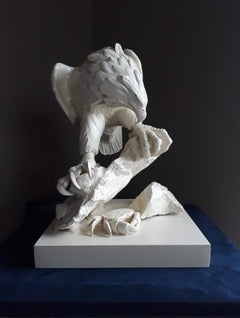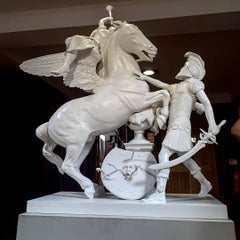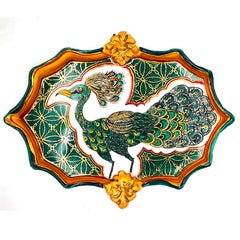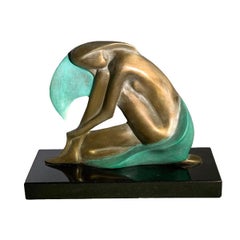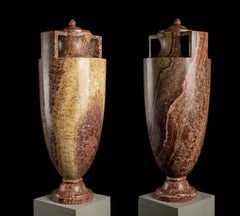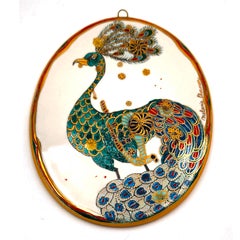Baroque Sculptures
to
6
14
8
4
4
7
3
4
Overall Height
to
Overall Width
to
17
8
4
14
10
8
7
5
4
3
1
1
1
1
1
1
1
1
1
1
22
11
9
25
3
2
3
7
2
9
7
7
5
4
Style: Baroque
Period: 18th Century and Earlier
White tailed sea eagle and crab
Located in Oswestry, GB
This white tailed sea eagle is depicted here on a rock on the shore of a remote wild Scottish Isle (Outer Hebrides). Hiding beneath the rock is a brown crab...
Category
16th Century Baroque Sculptures
Materials
Bronze
Perseus and Fame proclaiming the birth of Pegasus
Located in Oswestry, GB
This neo-classical style sculpture is of Perseus the son of Zues and Danae is ordered by King Polydectes to slay the gorgon Medusa. With the gift of a polished shield from Athena, a ...
Category
Early 17th Century Baroque Sculptures
Materials
Bronze
Discus Thrower's Torso
Located in Oswestry, GB
This artwork emulates the classical statues from the ancient world, particularly with the head broken off at the base of the neck if carved in marble. In fact I went to the lengths o...
Category
17th Century Baroque Sculptures
Materials
Granite, Bronze
Greyhound
Located in Oswestry, GB
What is unique about this artwork is the grace and elegance of the greyhound but designed in a most difficult stance frought with technical challenges. Yet the result offers a stance...
Category
Early 17th Century Baroque Sculptures
Materials
Bronze
Laocoön And His Sons Bronze
Located in New Orleans, LA
Laocoön and his Sons
Italian Bronze Group after Agesander, Polydorus and Anthenodorus
Late 18th Century
“The greatest piece of art in the world.”
- Michelangelo, Italian sculptor, p...
Category
Late 18th Century Baroque Sculptures
Materials
Bronze
Baroque master sculptor - 18th century terracotta sculpture - Prometheus figure
Located in Varmo, IT
Terracotta sculpture - Prometheus - Italy, 18th century.
48 x 50 cm x h 94 cm.
Entirely in terracotta.
- All shipments are free and professionally packed.
- This item is sold wit...
Category
Early 18th Century Baroque Sculptures
Materials
Terracotta
Vintage Peacock III (Wall Piece/Dish (hand-painted, made to order by the artist)
Located in Kansas City, MO
Melanie Sherman
Vintage Peacock III (Wall Piece/Dish (handpainted)
Porcelain, Glaze, Overglaze, Chinapaints, 24k German Gold Luster, Brass Wire (for hanging, can be removed)
Year: 20...
Category
1790s Baroque Sculptures
Materials
Brass
A French Statue of Saint John the Baptist, Circa 1700, polychromed wood
Located in Bruges, BE
Description: A French Statue of Saint John the Baptist with Staff and Lamb on his Feet, Circa 1700, polychromed wood
Statue: Shepherd with Lamb on his Feet
Object Type: Religious St...
Category
17th Century Baroque Sculptures
Materials
Paint, Wood
Renaissance Era Marble Figure Fragment
Located in Newport Beach, CA
An extraordinary 17th century, hand-carved, solid Carrara marble, life sized figure fragment on raised base of the same. The subject is swaddled in a luxurious, gathered robe and tun...
Category
17th Century Baroque Sculptures
Materials
Marble
A late 17th Italian carved limewood figure of Mermaid, circle of Filippo Parodi
Located in PARIS, FR
A late 17th c. Italian carved figure of Mermaid,
Circle of Filippo Parodi (Genoa, 1630 – July 22, 1702)
Dimensions: h. 29.13 in, w. 30.31 in, p. 18.9 in (at the base)
Magnificent Italian Baroque sculpture depicting a mermaid seated on the rock.
All the virtuosity of the sculptor unfolds in this carved group. The fantastic creature is featured seated, the upper part of the body darting forward, the head looking upwards. Sophisticated hairstyle with rows of pearls intertwined in her hair, her loose locks fly in the wind and bring movement to the whole sculpture.
The wide-open eyes with hollowed-out pupils make it possible to follow the mermaid's gaze, towards the sky. The half-open mouth further magnifies this bewitching and seductive attitude.
Its long double tail ending in fins wraps on either side of a rocky mound strewn with objects evoking the underwater world: seashells and shells, branches of coral.
The ornamental richness combined with the great care taken in its execution make it a work in which the splendor of Italian Baroque art unfolds in such characteristic scenic movement.
The composition betrays a strong influence from Filippo Parodi, the leader of Genoese Baroque sculpture, and points to an artist from his circle.
Our sculpture was probably part of a decorative monumental palace.
The iconographic theme evoking the marine world finds its application in the numerous fountains and artificial grottos, designed in Italian palaces at the turn of the 17th and 18th centuries.
Giacomo Filippo Parodi (Genoa 1630 – July 22, 1702) was an Italian Baroque sculptor of the Genoese school, who introduced Bernini's aesthetic to Genoa.
In his youth fathers a first apprenticeship with a carpenter, he went to Rome where he became a pupil of Bernini.
He had the opportunity to admire in person the works and style of the French sculptor Pierre Puget...
Category
Late 17th Century Baroque Sculptures
Materials
Wood
Laocoön And His Sons By Adriaen De Vries
Located in New Orleans, LA
Adriaen de Vries
1556-1626 Dutch
Laocoön and His Sons
Bronze
A remarkable feat of artistry and skill, this bronze sculpture was created by famed Dutch artist Adriaen de Vries. Full of the swelling emotions and dramatic posing so quintessential to the period, the bronze is a masterclass in Baroque sculpture.
The original Laocoön marble sculpture, after which this remarkable bronze was modeled, unquestionably influenced the lives and works of countless artists, authors, popes, kings and emperors since its re-discovery in 1506. Famously, Michelangelo declared the sculpture, created circa 35 BC, as the “greatest piece of art in the world.” Adriaen de Vries, an apprentice of the great sculptor Giambologna, undoubtedly sought to prove his skill and creative voice with his own depiction of this most famous scene. Known for his virtuosic casting technique, this rare and important sculpture embodies de Vries’ mastery.
The story of Laocoön is one of the most famous in all of literature. As told by the poet Virgil, the Greeks, after an unsuccessful ten-year siege on the city of Troy, the Greeks craftily left a giant wooden horse outside the gates...
Category
16th Century Baroque Sculptures
Materials
Bronze
Polychrome Carved Mexican Sculpture -- Child Jesus
Located in Troy, NY
This is a hand-carved wood polychromed sculpture of the Infant Jesus. A baroque figure probably from the 18th century, this religious figure was obtained in Mexico. It appears to hav...
Category
18th Century Baroque Sculptures
Materials
Wood, Paint
17th C Polychromed fruitwood carved statue depicting Madonna, France.
Located in brussel, BE
An exceptionally beautiful antique French wood carving, made in the 17th century. It depicts Madonna standing with open offering arms .The...
Category
17th Century Baroque Sculptures
Materials
Wood
Bronze of Pluto Abducting Proserpine after François Girardon
Located in New Orleans, LA
After François Girardon
1628-1715 French
Pluto Abducting Proserpine
Bronze
This High Baroque period composition captures the famed narrative of Pluto and Proserpine from Roman mythology. The late 17th-century patinated bronze, created after François Girardon's marble composition, captures the very moment that Pluto seizes Proserpine. The anguished goddess reaches skyward, attempting to escape the god’s grasp while Pluto’s stoic face betrays his knowledge that his ploy will succeed. This pivotal moment in the mythological tale has captured the imagination of many art historical greats, from Bernini to Rubens. François Girardon’s version of the climax demonstrates incredible finesse and artistry, modeled expertly in bronze in the present work by a later sculptor. The statue brings a twist of intertwined bodies into a dynamic frenzy, paralleling the tension of the legendary story.
In ancient Roman mythology, Proserpine, the beautiful daughter of Ceres — known as Persephone in Greek mythology — was picking flowers in the fields when she was suddenly abducted by Pluto, the god of the underworld, and taken to his kingdom. Consumed with grief, her mother Ceres, the goddess of agriculture, scorches the earth, stopping the growth of grain and fruit. Jupiter attempts to intervene and secure Proserpine’s return to earth, negotiating a compromise with Pluto and the Fates that allows Proserpine to be released for part of the year before returning to Pluto’s underworld. Proserpine’s journey back and forth is an allegory for the changing seasons; when Prosperine is with her mother, the earth warms and provides bountiful harvests. Upon her annual return to the underworld, however, the earth once again becomes cold and barren.
After returning to France after years of training in Rome, François Girardon quickly rose to become one of the greatest artists in France. He was elected a member of the Académie Royale de Peinture et de Sculpture in 1657 and would become Chancellor of the Royal Academy in 1695. The artist was approached frequently for royal commissions and Girardon’s Pluto was originally commissioned by Louis XIV for the gardens at his Palace of Versailles. It was one of four monumental marble groups intended to decorate the corners of Charles Le Brun’s never completed garden at the chateau, the Parterre d’Eau. Each group of three figures symbolized one of the four elements: earth, air, fire and water. Pluto’s association with hell made him the apt...
Category
Early 18th Century Baroque Sculptures
Materials
Bronze
17th C Stone statue of Saint Erasmus or Saint Elmo
Located in brussel, BE
Saint Erasmus or Saint Elmo (Antioch, ca. 240 – Formia, 303) was an Italian bishop and patron saint of the sailors. His attribute was the capstan, a winch on which the anchor chains were rolled up. He died as a martyr for his faith, and his bones were transferred to Gaeta in the 9th century, where they are kept in the cathedral to this day. The electric phenomenon of Saint Elmus fire is named after Saint Erasmus and the 16th C humanist Desiderius Erasmus. Little is known with certainty about Saint Erasmus' life. However, many legends may have been passed on orally until - no older writings are known with certainty. His birthplace was in present-day Syria. However, the persecution of Christians under Emperor Diocletian forced him to flee to Mount Lebanon...
Category
17th Century Baroque Sculptures
Materials
Stone
Roman 18th century terracotta model for the sculpture of San Camillo de Lellis
Located in London, GB
This remarkably fluid terracotta bozetto was made in preparation for Pietro Pacilli’s most important public commission, a large-scale marble statue of San Camillo de Lellis for the nave of St Peter’s Basilica in Rome. Expressively modelled, this terracotta sculpture is a rare and significant work made by a major Roman sculptor at a transformative moment of European sculpture. Pacilli began his working life on the great Baroque decorative projects initiated in the seventeenth century, but he found success as a restorer of ancient sculpture working to finish antiquities for a tourist market, becoming an important figure in the emergence of an archaeologically minded Neoclassicism. Pacilli trained Vincenzo Pacetti and provided important decorative work for the Museo Pio-Clementino, at the same time he is recorded restoring some of the most celebrated antiquities excavated and exported during the period.
Pacilli was born into a family of Roman craftsmen, his father Carlo was a wood carver, and Pacilli is recorded working with him on the Corsini Chapel in San Giovanni Laternao as early as 1735. In 1738 his terracotta model of Joseph and Potiphar’s Wife won the first prize in the second class of the sculpture concorso at the Accademia di San Luca, this is particularly notable as Bartolomeo Cavaceppi came third. He worked as a carver and stuccoist completing works for the churches of San Marco and SS. Trinita dei Domeniciani Spagnoli. Pacilli operated as a sculptor and restorer of antiquities from his studio at the top of the Spanish Steps, close to Santa Trinita dei Monti, where he is listed as a potential vendor to the Museo Pio-Clementino in 1770.
In 1763 Pacilli completed a silver figure of San Venanzio for the treasury of San Venanzio. He is recorded as Pacetti’s first master and it was evidently through Pacilli that he began to acquire his facility as a restorer of ancient sculpture. Pacilli, at his studio ‘poco prima dell’Arco della Regina alla Trinita dei Monti,’ exercised, what the nineteenth-century scholar, Adolf Michaelis called ‘rejuvenating arts’ on several important pieces of classical sculpture, including in 1760 the group of a Satyr with a Flute for the natural brother of George III, General Wallmoden, Hanovarian minister at Vienna. In 1765, Dallaway and Michaelis record that Pacilli was responsible for the restorations, including the addition of a new head, to the Barberini Venus which he had acquired from Gavin Hamilton. The Venus was then sold to Thomas Jenkins, who in turn passed it on to William Weddell at Newby Hall. In 1767 Pacilli exported a series of ancient busts ‘al naturale’ including portraits of Antinous, Julius Ceaser and Marus Aurelius, also a statue of a Muse and a Venus. As early as 1756 Pacilli seems to have been operating as an antiquarian, helping to disperse the collection of the Villa Borrioni. Pacilli supplied sculpture to notable British collectors, including Charles Townley, who on his first trip to Italy purchased the Palazzo Giustiniani statue of Hecate from Pacilli. Pacilli was involved with the Museo Pio Clementino from its conception, supplying busts of Julius Ceaser and a Roman Woman as well as completing stucco putti surmounting the arms of Pope Bendedict XIV to signal the entrance to the new Museo Critiano.
In 1750 Il Diario Ordinario del Chracas announced that Pacilli had begun work on a sculpture of San Camillo de Lellis for St Peter’s. Camillo de Lellis founded his congregation, the Camillians, with their distinctive red felt crosses stitched on black habits in 1591. Having served as a soldier in the Venetian army, Camillo de Lellis became a novitiate of the Capuchin friars, he moved to Rome and established a religious community for the purpose of caring for the sick. In 1586 Pope Sixtus V formerly recognised the Camillians and assigned them to the Church of Santa Maria Maddalena in Rome. Camillo de Lellis died in 1614 and was entombed at Santa Maria Maddalena, he was canonised by Benedict XIV on June 26, 1746. It was an occasion that prompted the Camillians to make a number of significant artistic commissions, including two canvases by Pierre Subleyras showing episodes from San Camillo’s life which they presented to Benedict XIV. In 1750 Pacilli was commissioned to fill one of the large niches on the north wall of the nave with a sculpture of San Camillo.
The present terracotta bozetto presumably had two important functions, to enable Pacilli to work out his ideas for the finished sculpture and at the same time to show his design to the various commissioning bodies. In this case it would have been Cardinal Alessandro Albani and Monsignor Giovan Francesco Olivieri, the ‘economo’ or treasurer of the fabric of St Peter’s. Previously unrecorded, this terracotta relates to a smaller, less finished model which has recently been identified as being Pacilli’s first idea for his statue of San Camillo. Preserved in Palazzo Venezia, in Rome, the terracotta shows San Camillo with his left hand clutching his vestments to his breast; the pose and action more deliberate and contained than the finished sculpture. In producing the present terracotta Pacilli has expanded and energised the figure. San Camillo is shown with his left hand extended, his head turned to the right, apparently in an attempt to look east down the nave of St Peter’s. The model shows Pacilli experimenting with San Camillo’s costume; prominently on his breast is the red cross of his order, whilst a sense of animation is injected into the figure through the billowing cloak which is pulled across the saint’s projecting right leg. The power of the restrained, axial contrapposto of bent right leg and outstretched left arm, is diminished in the final sculpture where a baroque fussiness is introduced to the drapery. What Pacilli’s terracotta demonstrates, is that he conceived the figure of San Camillo very much in line with the immediate tradition of depicting single figures in St Peter’s; the rhetorical gesture of dynamic saint, arm outstretched, book in hand, head pointed upwards was perhaps borrowed from Camillo Rusconi’s 1733 sculpture of St. Ignatius...
Category
18th Century Baroque Sculptures
Materials
Terracotta
A pair of late 17th century Northern European carved oak angels
Located in Bath, Somerset
A pair of carved oak angels, circa 1700, with a lovely warm patina and faint traces of polychrome to the face and gilding to the body. The angels are both kn...
Category
17th Century Baroque Sculptures
Materials
Oak
Just A Little Tipsy (MADE TO ORDER) (Sabbath, Kiddush, Unique, Gold Luster)
Located in Kansas City, MO
(MADE TO ORDER) (Sabbath, Kiddush, Unique, Gold Luster)
*Lead Time may vary between 1-3 weeks
Melanie Sherman
"Just A Little Tipsy"
Year: 2021
Porcelain, Glaze, ChinaPaint, 24k Germ...
Category
Late 17th Century Baroque Sculptures
Materials
Luster, Porcelain, Glaze
Tuscan Baroque Nude Putto Candle Holder 17-18 century gilded wood
Located in Florence, IT
One flame candle holder putto made of gilded wood.
Those kind of objects were present in churches or noble villas, specially during the Baroque times.
The base is not coeval.
Category
17th Century Baroque Sculptures
Materials
Gold
Bust of a Lady, prob Queen Elisabeth Petrowna, Terracotta Sculpture, Baroque Art
Located in Greven, DE
Bust of a Lady, thought to be Elisabeth Petrowna, also known as Elisabeth of Russia
Depicted before she was crowned
Terracotta Bust
Elizabeth Petrovna (Russian: Елизаве́та (29 Decem...
Category
18th Century Baroque Sculptures
Materials
Terracotta
Late 17th C, Baroque, Saint, Italian School, Wooden Sculpture of Saint Anthony
Located in brussel, BE
The impressive life-size statue of St. Anthony (Lisbon, 1195 – Padua, 1231) used to be probably in a church or monastery of the mendicant order of the Franciscans. You can immediately recognize a Franciscan monk by his brown habit, brown hooded cloak...
Category
17th Century Baroque Sculptures
Materials
Wood
Bust of Pope Innocent XI Odescalchi by Domenico Guidi
Located in New Orleans, LA
This monumental bust is a museum-quality example of Roman Baroque sculpture. Crafted by the legendary Domenico Guidi and carved from Carrara marble, the impressive portrait captures the visage of Pope Innocent XI, Benedetto Odescalchi (1611-1689). It presents a larger-than-life example of Guidi’s remarkable skill as a sculptor, which ultimately made his workshop one of the most important in Rome during his age. Today, his works are rarely found on the market, particularly his extraordinary works in marble.
Pope Innocent XI was born Benedetto Odescalchi into an Italian noble family of prominent bankers. Spending his early years in banking, he eventually turned to the law, earning his doctorate in 1639. His background would serve him well in his service to the papacy, and he became known as a frugal and devout member of the Church. In 1676, he was unanimously elected Pop after the death of Clement X. During his nearly 13-year reign, he instilled his own personal ideals of austerity and frugality onto the Church, with a deep commitment to reform and piety.
He is captured here by Guidi in his traditional Pope’s mozzetta and camauro cap. A wide stole is draped over his shoulders, ornamented by acanthus leaves and the coat of arms of the Odescalchi family. It displays Guidi’s mastery over the chiaroscuro effect, particularly in the high level of contrast in his cheeks and his eyes, which Guidi achieved through various methods of high polish.
A very similar portrait sculpture of Pope Innocent XI by Guidi can be found in the collection of the Royal Castle in Warsaw. The Warsaw bust belongs to a series of portraits of popes which the Odescalchi family commissioned from Domenico Guidi in the 1690s. Compared to that example, the present bust is far more dramatic, with deeper cut lines and a more precise expression. It is likely that the present piece was seen by the Odescalchi family, who ordered a similar one to be made. The piece was almost certainly intended to be displayed in a niche, given its dramatic cutting and its roughly carved back.
Others of Guidi’s busts can be found in important collections throughout Italy, England and the United States, though many of these are lesser bronze repetitions. A bronze bust of the Pope Alexander VIII by Guidi is currently in the collection of the Victoria & Albert Museum (London), while a terracotta version of the same is in the Los Angeles County Museum. A bronze of Pope Alexander VIII can be found in the Princely Collection of Lichtenstein, and his impressive marble papal bust of Clement IX graces the pope’s tomb in Santa Maria Maggiore. The present bust of Pope...
Category
17th Century Baroque Sculptures
Materials
Marble
Related Items
Vintage Peacock I (Wall Piece/Dish) (MADE TO ORDER) (~50% OFF LIMITED TIME ONLY)
Located in Kansas City, MO
(MADE TO ORDER) (Hand-painted, hand-made, porcelain)
*Lead Time may vary between 1-3 weeks
Melanie Sherman
Vintage Peacock I (Wall Piece/Dish (handpainted)
Porcelain, Glaze, Overglaze, Chinapaints, 24k German Gold Luster, Brass Wire (for hanging, can be removed)
Year: 2022
Size: 4.5x6x0.5in
Signed by hand
COA provided
Ref.: 924802-1330
------------------------
My ceramics are handmade and painted with the finest overglazes from Europe. The gold luster used is 24k liquid Gold from Germany. Every piece is unique. My imagery is inspired by vintage Meissen dinnerware...
Category
2010s Baroque Sculptures
Materials
Brass
Jupiter 3
Located in Palm Desert, CA
My Jupiter Series is part of a new series of pieces started while quarantining in this pandemic time. They are hand cast solid bronze relief sculptures mounted on black granite bases...
Category
21st Century and Contemporary Baroque Sculptures
Materials
Granite, Bronze
French Terracotta Sculpture Studio Torso Belvedere Grand Tour Style 19th Century
Located in Roma, IT
a very interesting sculpture, a studio of the Belvedere Torso made in french in the 19th Century. Standing on a double order circular wood base, the sculpture present an harmonic and...
Category
19th Century Baroque Sculptures
Materials
Terracotta, Wood
No Reserve
H 12.6 in W 8.67 in D 9.85 in
Quinto Martini Female Nude Sculpture 20 century terracotta signed.
Located in Florence, IT
This small terracotta statue portrays a lady laying on a very sensual and athletic position. Is signed on the base Quinto M. Even if it's not dated, we can premusably suggest a perio...
Category
Mid-20th Century Baroque Sculptures
Materials
Terracotta
Vintage Peacock III (Wall Piece/Dish (hand-painted, made to order by the artist)
Located in Kansas City, MO
Melanie Sherman
Vintage Peacock III (Wall Piece/Dish (handpainted)
Porcelain, Glaze, Overglaze, Chinapaints, 24k German Gold Luster, Brass Wire (for hanging, can be removed)
Year: 20...
Category
1790s Baroque Sculptures
Materials
Brass
Terracotta figurativa italiana a tema mitologico dei primi del Novecento
Located in Florence, IT
Piccola terracotta a soggetto mitologico firmata sul retro sulla base "Zambini", che per la grafia (in particolare la Z che ricorda una F) permette di identificare l'artista con Ferr...
Category
Early 20th Century Baroque Sculptures
Materials
Terracotta
A lady. Contemporary bronze sculpture, Abstract & figurative, Polish art
Located in Warsaw, PL
Contemporary bronze sculpture on marble base by Polish artist Stan Wysocki. Artwork comes from limited edition of 8. Sculpture depicts female figure filtered through geometric, synth...
Category
2010s Baroque Sculptures
Materials
Granite, Bronze
H 7.88 in W 6.7 in D 7.09 in
17th C Polychromed fruitwood carved statue depicting Madonna, France.
Located in brussel, BE
An exceptionally beautiful antique French wood carving, made in the 17th century. It depicts Madonna standing with open offering arms .The...
Category
17th Century Baroque Sculptures
Materials
Wood
Sculpture Torso Belvedere Grand Tour Style 19th Century Terracotta Academical
Located in Roma, IT
a very interesting sculpture, a studio of the Belvedere Torso made in french in the 19th Century. Standing on a double order circular wood base, the sculpture present an harmonic and...
Category
19th Century Baroque Sculptures
Materials
Terracotta, Wood
H 12.6 in W 8.67 in D 9.85 in
Bust in patinated plaster " terracotta style " 19th century with Louvre seal
Located in Gavere, BE
Important patinated plaster bust representing the Faun of Vienna.
the original of which is in the collections of the Louvre museum (marble statue discovered in Vienna in 1820 and dat...
Category
1870s Baroque Sculptures
Materials
Plaster
H 21.66 in W 18.12 in D 11.82 in
Pair of Exceptional Italian Sphinx Limestone Statues
Located in Rome, IT
Designed as entrance guardians, this pair of mythical lady sphinx statuary display the head and chest of a neoclassical woman and the body of a recu...
Category
2010s Baroque Sculptures
Materials
Limestone
Joan of Arc
Located in Oswestry, GB
Joan of Arc is depicted here at a solo exhibition in St. Edwards chapel at St. David's Cathedral, South Wales. Hand carved from a solid block of Carrara marble imported from Italy, Davies used traditional tools also used by the master sculptors of the renaissance. She is life size and expresses purity of soul as you see her in Divine contemplation. This portrait bust sits proportionately on a marble socle, the design of which is from the classical Ionic order.
Category
2010s Baroque Sculptures
Materials
Marble
Previously Available Items
Pair Of Sculptured Vase In Specimen Marble 18th by GrandJaquet Guillaume-Antoine
Located in Roma, IT
Antoine Guillarme GrandJacquet Important Pair of decorative lidded vases made in Alabastro Marino. Above a round hood-like base, the body in an elongated ovoid shape with a pair of folded handles developing from the vertical of the body, which connects to the upper end of the double-conical neck and flanks the decorative hood lid with a tenon knob; The smooth surface of the body, in addition to enhancing the incredible quality of the alabaster used, accentuates, by contrast, the animated play of shadows created by the veins in the surface.
Antoine Guillarme GrandJacquet, was born in Reugney, in Franche-Comté (today's department of Doubs), on 19 June 1731 to Claude-Étienne and Jeanne-Françoise Troutet (Castan, p. 69). He soon devoted himself to sculpture and around 1765 he arrived in Rome, where he remained until his death. Linked to the Burgundian Brotherhood present in the city, he became its secretary from 1769 to 1793, and then rector. For 270 Roman scudi, to which he added a supplement of 20 , in 1771 he modeled the statue...
Category
18th Century Baroque Sculptures
Materials
Marble
Vintage Peacock III (Wall Piece/Dish (hand-painted)
Located in Kansas City, MO
Melanie Sherman
Vintage Peacock III (Wall Piece/Dish (handpainted)
Porcelain, Glaze, Overglaze, Chinapaints, 24k German Gold Luster, Brass Wire (for hanging, can be removed)
Year: 20...
Category
1790s Baroque Sculptures
Materials
Brass
Pair of Bronze Horses Attributed to Jean-Baptiste Tuby
Located in New Orleans, LA
This exceptional pair of bronze horses are attributed to royal French sculptor Jean-Baptiste Tuby, and they recall the lavishly decorated gardens...
Category
17th Century Baroque Sculptures
Materials
Bronze
Italian Hand Carved Wood Madonna and Child on Crescent Moon Religious Sculpture
Located in Firenze, IT
Extremely representative Northern Italian school hand carved wooden sculpture from early 18th century featuring a serene Madonna with child standing above the terrestrial globe and crescent moon.
This solid lime wood sculpture of a crowned Virgin Mary holding the Baby Jesus in her arms evokes the traditional motif of the Madonna and child, transmits calm and maternal sweetness and at the same time is extremely strong and rich in symbolic elements.
This wonderful religious sculptural group depicting the Madonna standing on the globe with the symbol of the crescent moon beneath her feet is an allusion to the Apocalyptic Woman (Rev. 12:1–5).
The devil under symbolically represented in the form of a dragon holding an apple in its mouth is a reference to the original sin.
Furthermore, the presence of this additional symbolic element can make us interpret the moon as a symbol of inconstancy here vanquished beneath the feet of the Virgin.
The Holy Mary turns her gaze downwards, whilst tenderly holding the child in her arms, who interacts with the viewer rather than with his mother. The richness of the superb carving continues on the base which is embellished by high relief sculpted winged cherub faces and a scroll with golden lettering in Latin referring to the Holy Virgin Mary.
The whole model is extremely pleasant, transmitting a sense of harmony, peace and calm. Both the Virgin and the Holy Child have an embossed silver sheet crown. The sculpture rests on a rectangular wooden socle added later.
This sculpture was probably once hung in a church or private chapel, maybe as a part of an altarpiece, since it retains the original antique hook in the back. This beautiful sculpture can now be hung on the wall again or remain on the base as a fine art piece sculpted in the round.
The sculpture is in overall good condition considering age and use, the wood has a wonderful color and grain and original patina. Very old restoration of both sides of the cresent moon...
Category
18th Century Baroque Sculptures
Materials
Silver, Iron
H 26.78 in W 11.03 in D 5.91 in
Saint Mary Magdalene, a white marble medallion, after Etienne Le Hongre
Located in PARIS, FR
This marble medallion shows strong similarities to Etienne Le Hongre’s reception piece at the Royal Academy of Painting and Sculpture, which is now kept in the Notre-Dame Church in Versailles. While the suppleness of this sculpture evokes the Italian workshops frequented by Le Hongre before his arrival in Paris, the use of marble (and not terracotta, as was generally the case for the modelli) indicates that it is an independent artwork. It has not been possible, however, to determine whether this marble is an early work by Etienne Le Hongre, or a later interpretation of his reception piece, executed in a reduced format, by one of the Academy's students.
1. Etienne Le Hongre
Etienne Le Hongre was admitted to the Royal Academy of Painting and Sculpture in 1653, after his apprenticeship in the workshop of the sculptor Jacques Sarazin (1592 - 1660), and a three-year sojourn in Italy. He was finally admitted to the Academy in 1667 after the presentation of a marble high-relief featuring Saint Mary Magdalene...
Category
Early 18th Century Baroque Sculptures
Materials
Marble
H 16.34 in W 13.59 in
Large Louis XIV Mirror Richly Carved Gilded Florence 17/18th Century Gold Glass
Located in Riva del Garda, IT
Superb and large mirror, work of a Tuscan sculptor active between the end of the 17th century and the beginning of the 18th century
Tuscany (Florence)
Louis XIV period
Richly carved...
Category
Late 17th Century Baroque Sculptures
Materials
Gold
18th C, Late Baroque, Religious, Flemish Shool, Sculpture of an Angel
Located in brussel, BE
This elegant, beautifully polished angel holds his hands together as if in prayer. The sculpture may have been part of a wooden pulpit. The fact that the statue has been carefully wo...
Category
18th Century Baroque Sculptures
Materials
Oak
H 22.05 in W 14.57 in D 15.36 in
Baroque Spanish 17th Century Winged Angel early wood sculpture carving
Located in Norwich, GB
Everyone can do with an Angel, and this one is particularly lovely, depicted as a winged youth carrying a martyr's palm. Spanish in origin, he was sculpted in the 1600s, and has rema...
Category
17th Century Baroque Sculptures
Materials
Wood
H 11.82 in W 3.94 in D 3.94 in
Mirrors Gold Wood 18th Century Italy Baroque Art Interior Design
Located in Riva del Garda, IT
Magnificent pair of mirrors
Italy, Genoa
Second half 700
Carved and gilded wood
Antique mirrors in silver mercury glass
Dimensions: cm. 73 x 46.5
Pair of mirrors of Ligurian manufa...
Category
Late 18th Century Baroque Sculptures
Materials
Wood
Florentine Artist Mascherone fountain Figurative sculpture 18th century marble
Located in Florence, IT
The mascherone was used as a fountain and it was probably commissioned for the garden of a Villa. It can be dated to the end of the 18th beginning of the 19th century and it's inspir...
Category
Late 18th Century Baroque Sculptures
Materials
Marble
H 8.67 in W 7.49 in D 4.73 in
17th century Italian gilded bronze plate - Madonna Baroque sculpture Italy
Located in Varmo, IT
In gilded bronze, depicting "Ascension of the Virgin".
Category
17th Century Baroque Sculptures
Materials
Bronze
Peruvian 18th Century Huamanga Stone
Located in Kensington, MD
Peruvian 18th Century Huamanga Stone
Peru circa. 1750 18th Century
Huamanga Stone (Alabaster)
9.5" x 16" x 5" inches without base
11" x 12" x 6" inches with base
Category
18th Century Baroque Sculptures
Materials
Stone, Alabaster
Baroque sculptures for sale on 1stDibs.
Find a wide variety of authentic Baroque sculptures available for sale on 1stDibs. Works in this style were very popular during the 21st Century and Contemporary, but contemporary artists have continued to produce works inspired by this movement. Many Pop art paintings were created by popular artists on 1stDibs, including Albert-Ernest Carrier-Belleuse, Antoine-Louis Barye, and Giovan Domenico Lombardi Omino. Frequently made by artists working with Stone, and Marble and other materials, all of these pieces for sale are unique and have attracted attention over the years. Not every interior allows for large Baroque sculptures, so small editions measuring 9 inches across are also available. Prices for sculptures made by famous or emerging artists can differ depending on medium, time period and other attributes. On 1stDibs, the price for these items starts at $1,140 and tops out at $138,000, while the average work sells for $7,834.
Recently Viewed
View AllMore Ways To Browse
Fruit Figurines
Outdoor Sculpture Art Deco
Outdoor Hanging Sculpture
Contemporary Wearable Art Jewelry
Bronze Airplane
Ancient Views Of Shanghai
Nu Sculpture
Samurai Cat
Japanese Cat Figurine
Minotaur Sculpture
Emergency Glass
Panda Sculpture
Noguchi Stone
Raw Minerals
Lee Bontecou
In Case Of Emergency
Abstract Bronze Sculpture Netherlands
Red Panda
